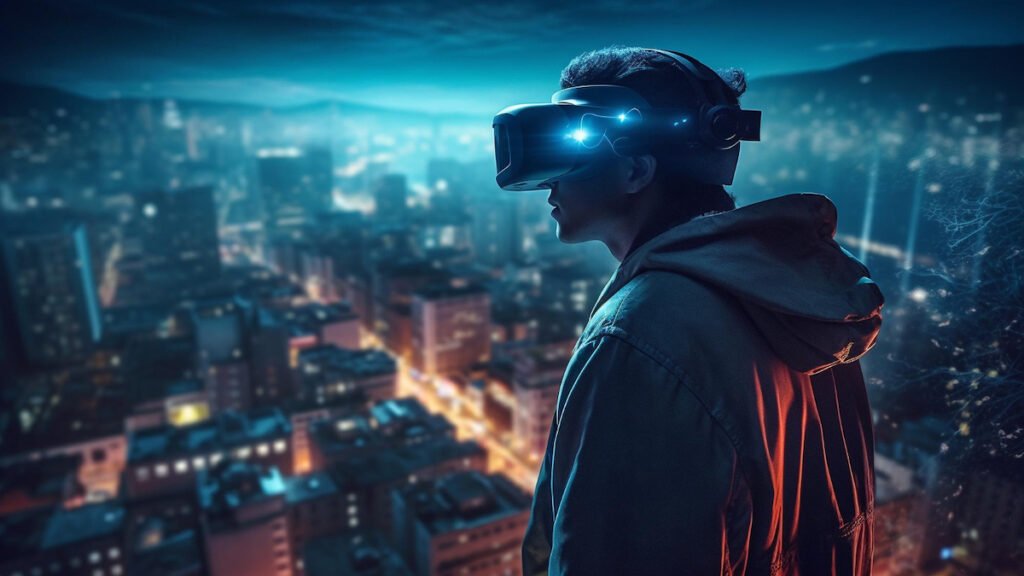In recent years, the term “metaverse” has become a buzzword in the tech industry. It has been touted as the future of technology and virtual experiences, with some even saying that it will revolutionize our way of life. But what exactly is the metaverse? And why does the emergence of metaverses matter?
Metaverse Definition and Explanation
The metaverse can be defined as a collective virtual shared space, created by the convergence of physical and digital worlds. It is a fully immersive and interactive virtual environment, or ‘meta’, where people can interact in real-time, create and share content, and engage in various activities like in a video game.
In simpler terms, think of it as a parallel universe that exists within the digital realm like in notable metaverses. The metaverse is a place where people can escape from reality and enter into a new world of endless possibilities, much like a video game.
Understanding the Development of the Metaverse
The concept of the metaverse has been around for decades, but it was only in recent years that technology has caught up to make it a viable possibility. The idea of creating a virtual world where people can interact and engage with each other was first introduced in Neal Stephenson’s 1992 science fiction novel “Snow Crash.”
Since then, various technologies such as virtual reality (VR), augmented reality (AR) and blockchain have advanced, making the development of the metaverse more attainable.
The History and Evolution of the Metaverse
The term “metaverse” was coined by sci-fi writer Vernor Vinge in his 1981 novel “True Names.” However, the concept of virtual worlds can be traced back even further to films like “Tron” in 1982 and “The Matrix” in 1999.
In the early 2000s, online gaming platforms such as Second Life and World of Warcraft gave users a taste of what it could be like to exist in a virtual world. But it wasn’t until the release of VR headsets like Oculus Rift and HTC Vive that the idea of the metaverse truly took off. Now, the term metaverse is often used to describe a collective virtual shared space, created by the convergence of virtually enhanced physical reality and physically persistent virtual reality. It’s a space where users can interact with each other and digital objects in a computer-generated environment, and it’s becoming increasingly relevant as technology continues to evolve.
The Idea and Potential of the Metaverse
The metaverse has captured the imagination of many, with its potential to create a new form of human interaction and limitless possibilities for entertainment, education, and business.
One of the most significant advantages of the metaverse is its ability to transcend physical limitations. In a mixed reality world like the metaverse, distance and physical barriers are no longer obstacles, allowing people from all over the world to come together and collaborate seamlessly in real time.
The metaverse also offers endless opportunities for creators and entrepreneurs in fields such as gaming, art, fashion, and more. It provides a platform for them to showcase their talents and monetize their creations in a way that was not possible before.
The Term “Metaverse” and Its Implications
The term “metaverse” has been used loosely and interchangeably with other terms such as virtual worlds, digital universes, and the internet of things. However, it is important to note that these are all different concepts and should not be confused with the metaverse.
The term itself has significant implications for technology, as it suggests a shift towards a more immersive and interactive internet experience. It also highlights the potential for collaboration between various fields such as gaming, social media, and e-commerce.

Accessing the Metaverse
As the metaverse continues to evolve, there are multiple ways to access it and engage with its content. Here are some of the most common methods:
Ways to Access the Metaverse
- Through Virtual Reality (VR) Headsets: VR headsets such as Oculus Rift, HTC Vive, and PlayStation VR provide a fully immersive experience in the metaverse.
- Augmented Reality (AR): AR technology overlays digital content onto the physical world, allowing users to interact with virtual objects and characters in real-time.
- Web-Based Platforms: Some metaverse platforms can be accessed through web browsers, making it more accessible for those who do not have VR or AR devices.
- Mobile Apps: There are also mobile apps available that allow users to access the metaverse on their smartphones or tablets.
How to Prepare for and Get Into the Metaverse
As with any new technology, it is essential to prepare yourself for the metaverse and understand its potential impact. Here are some steps you can take to get ready:
- Familiarize yourself with VR and AR technology: If you want to fully immerse yourself in the metaverse, it’s crucial to have an understanding of VR and AR technology.
- Stay updated on the latest advancements: The metaverse is a rapidly evolving space, so it’s essential to stay up-to-date with the latest developments and trends.
- Invest in equipment or devices: If you are serious about accessing the metaverse, investing in VR or AR headsets may be necessary.
- Experiment with current metaverse platforms: There are already several metaverse platforms available, so take some time to explore and get a feel for what’s out there.
Platforms and Technology for Accessing the Metaverse
As mentioned earlier, there are multiple ways to access the metaverse, each with its unique technology and features. Here are some of the popular platforms being used to access the metaverse:
- VRChat: This popular platform allows users to create and customize avatars, interact with other users, and explore virtual worlds.
- Decentraland: Built on blockchain technology, Decentraland is a decentralized metaverse where users can buy land, build structures, and monetize their creations using cryptocurrency.
- Second Life: One of the oldest metaverse platforms, Second Life allows users to create avatars, explore virtual spaces, and engage in activities such as gaming, shopping, and socializing.
- Roblox: Originally a game creation platform for kids, Roblox has evolved into a metaverse where users can design games, play with friends, and even earn money through game development.
Interoperability and the Metaverse
One of the key factors for a successful metaverse is interoperability, meaning that users can seamlessly move between different platforms and experiences. This allows for a more cohesive and connected metaverse experience.
The development of interoperability standards and protocols is crucial in achieving seamless real-time interactions in metaverses. Blockchain technology is also playing a significant role in creating interoperable environments by allowing for digital assets to be transported and used across different platforms.
Use of the Metaverse
The metaverse has vast potential for various applications and experiences. Here are some examples of how it is being utilized:
Applications and Experiences within the Metaverse
- Gaming: The gaming industry has already embraced the metaverse, with virtual worlds like Fortnite and Minecraft attracting millions of users every day.
- Virtual Events: With the rise of virtual events and conferences, the metaverse provides a new and exciting platform for hosting and attending these gatherings.
- Education: Some educators are already exploring the use of the metaverse to create immersive learning experiences for students.
- Socializing: The metaverse allows people from all over the world to connect, interact, and socialize in virtual spaces.
The Future Potential of the Metaverse
The potential for the metaverse is vast and still largely unexplored. With advancements in technology, we can expect to see even more immersive and realistic virtual experiences that could have a significant impact on our daily lives.
Some envision a future where people will spend more time in the metaverse than the physical world, while others see the potential for improved communication, collaboration, and problem-solving through virtual interactions.

Challenges and Considerations
As with any emerging technology in 2022, especially one with Mark Zuckerberg’s involvement, there are challenges and considerations that need to be addressed in the developing metaverses. Some of these include:
Ethical and Societal Implications
The metaverse raises questions about ethics and societal implications such as the blurring of reality and virtuality, digital identity, and ownership of virtual assets. One major ethical concern is the potential for people to become so engrossed in the metaverse that they neglect their real-world responsibilities and relationships. This could lead to a rise in social isolation and mental health issues.
Digital identity is also a concern, as people may spend so much time in the metaverse that their online persona becomes more important than their real-life self. This could lead to a loss of authentic human connection and a rise in identity theft and fraud.
Another issue is the ownership of virtual assets. As more people spend money on virtual goods and services, there will be questions about who truly owns these assets and what rights they have over them. This could lead to disputes over virtual property represented by non-fungible tokens (NFTs) in the metaverse and the potential for exploitation by those who control these emerging platforms.
There is also the potential for the metaverse to exacerbate societal divides, as those who are unable to participate in this digital world due to economic or technological barriers may be left further behind. This could widen the gap between the haves and have-nots in society.
Overall, the metaverse raises important ethical and societal questions that require careful consideration and regulation to ensure that it is a force for good and not a source of harm.
Privacy and Security Concerns
As more personal information in the form of non-fungible tokens (NFTs) is shared and stored in the metaverse in 2022, there are concerns about privacy and security. Data breaches, cyberattacks, and surveillance are all potential risks to consider. The metaverse, a virtual reality space where users can interact with each other and digital objects, has the potential to revolutionize the way we live, work, and play. However, there are significant privacy and security concerns that need to be addressed as the metaverse becomes more integrated into our daily lives.
One of the main concerns is the potential for data breaches. As more personal information is shared and stored in the metaverse, there is a risk that hackers could gain access to this data and use it for malicious purposes. This could include stealing sensitive information such as credit card numbers, social security numbers, or personal health information.
In addition to data breaches, there is also the risk of cyberattacks targeting the metaverse itself. As the metaverse becomes more complex and interconnected, there is the potential for cybercriminals to exploit vulnerabilities in the system and disrupt or sabotage the virtual reality environment.
Furthermore, surveillance is another concern in the metaverse. As users spend more time in virtual reality spaces, there is the potential for their actions to be monitored and tracked by companies or governments. This could lead to a loss of privacy and freedom for users, as their every move and interaction could be under scrutiny.
To address these concerns, it is important for companies developing the metaverse to prioritize privacy and security by implementing robust encryption, authentication, and access controls. Users also need to be educated about the risks and how to protect themselves, such as using strong passwords and being cautious about sharing personal information.
Ultimately, as the metaverse continues to evolve, it will be crucial for stakeholders to work together to develop policies and regulations that protect the privacy and security of users in this new virtual reality space. By addressing these concerns, we can ensure that the metaverse is a safe and secure environment for all who participate in it.
Regulation and Governance
The metaverse operates in a largely unregulated space, creating challenges for governing and policing behaviors and activities within the virtual world. This could lead to issues such as cyberbullying, scams, and illegal activities. With the development of the metaverse, it will be crucial to establish guidelines and regulations to ensure the safety and security of its users. This may include creating digital laws and ethics codes that govern behaviors and interactions within the metaverse, as well as implementing systems for reporting and investigating cybercrime.
Additionally, there will be a need for collaboration between governments, tech companies, and law enforcement agencies to address these challenges. This could involve the development of new technologies for monitoring and policing virtual spaces, as well as international cooperation to address cross-border issues.
In order to create a safe and trustworthy metaverse, it will be important for all stakeholders to work together to establish a framework for governance and policing that balances the principles of freedom and security. This will be an ongoing and evolving process as the metaverse continues to develop and expand.

Equity and Inclusivity
It’s crucial to consider access and inclusivity in the development of the metaverse. As with any technology, there is a risk of creating a digital divide where certain groups or individuals may be excluded from participating due to financial, technological, or other barriers. In order to ensure that the metaverse is accessible to all, developers and companies must prioritize inclusivity in their designs and policies. This may involve offering affordable or even free access to the metaverse, creating tools and interfaces that are user-friendly and accommodating to individuals with disabilities, and addressing potential biases or discrimination in the metaverse’s algorithms and systems.
It’s also important to consider the global aspect of the metaverse, as access and inclusivity issues can vary widely across different regions and cultures. This may require collaborating with local communities and organizations to understand and address specific barriers to access and participation.
Furthermore, education and awareness are key in ensuring that everyone has the opportunity to take part in the metaverse. This may involve providing resources and training to individuals who may not be familiar with the technology, as well as promoting digital literacy and responsible use of the metaverse.
Overall, creating an inclusive and accessible metaverse in 2022 requires intentional efforts from all stakeholders involved, including developers like Mark Zuckerberg. By prioritizing access and inclusivity, the metaverse can become a truly diverse and enriching space for all individuals to participate and thrive.
The Role of Big Tech and Major Companies
The metaverse is largely being developed and controlled by big tech companies and major corporations. This raises concerns about their influence and impact on the development and use of the metaverse. In order to address this, developers and stakeholders involved in the creation of the metaverse need to prioritize accessibility and inclusivity. This means making sure that the technology is accessible to people with disabilities, ensuring that the infrastructure for accessing the metaverse is available to people in all regions and socioeconomic backgrounds, and designing platforms and experiences with diverse users in mind.
One way to ensure inclusivity is to involve representatives from different communities and marginalized groups in the design and development process. By including their perspectives and experiences, developers can create a more inclusive and diverse metaverse that considers the needs of all potential users.
Additionally, efforts should be made to provide affordable access to the necessary technology and infrastructure for participating in the metaverse. This could involve initiatives to provide low-cost or subsidized hardware and internet access to underserved communities, as well as creating opportunities for digital skills training and education.
Overall, prioritizing access and inclusivity in the development of the metaverse is essential to ensure that it doesn’t exacerbate existing inequalities and that it can be enjoyed by all. By taking proactive steps to address these issues, the metaverse has the potential to become a more equitable and inclusive digital space for everyone.
Preparing for the Metaverse
With the potential impact of the metaverse, it’s essential to be prepared and informed about its development. Here are some ways you can prepare:
- Understand the Readiness and Potential Impact: Educate yourself on the current state and potential impact of the metaverse.
- Invest and Participate: For those interested in investing in the metaverse, there are opportunities available, such as buying virtual land or investing in startups developing metaverse technology.
- Develop Skills and Assets: As the metaverse continues to grow, there will be a demand for individuals with skills such as virtual world design, coding, and digital asset management.
- Education and Awareness: It’s essential to educate yourself and others about the metaverse to ensure responsible use and development.
- Create and Navigate Digital Avatars: As the metaverse is a virtual world, your digital avatar, kind of like your token, will represent you like in a video game. Learning how to create and navigate your avatar is crucial for a successful metaverse experience.
In conclusion, the metaverse is an ever-evolving concept that holds immense potential for various industries and experiences. It’s important to understand its development, challenges, and opportunities as we move towards a more connected and immersive virtual world. With proper preparation and consideration, the metaverse could bring about significant positive change, but it’s essential to address its challenges and implications carefully. So, let’s continue to explore and embrace the metaverse with an open mind and critical thinking. Let’s create a responsible and inclusive metaverse for all to enjoy.




